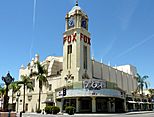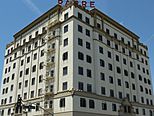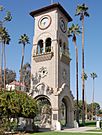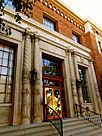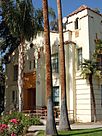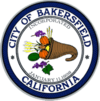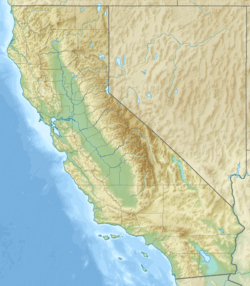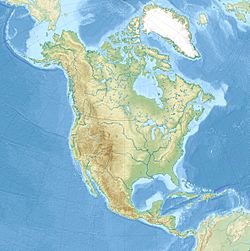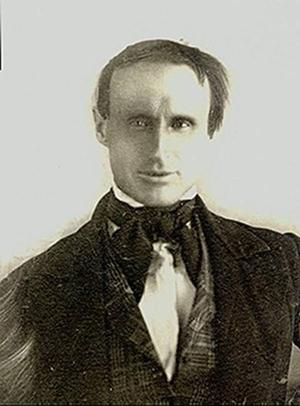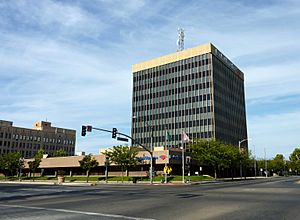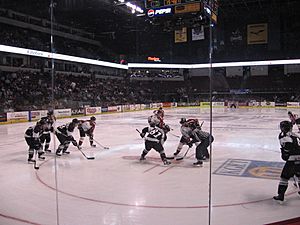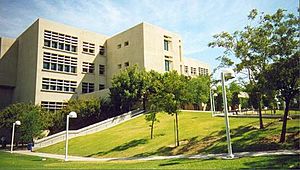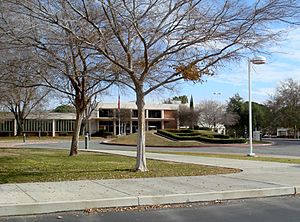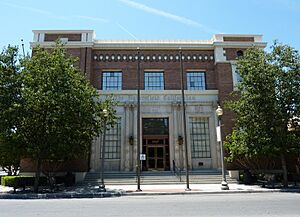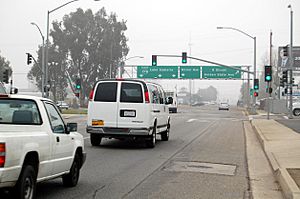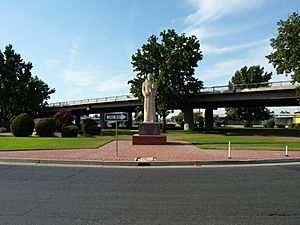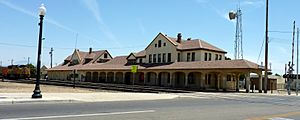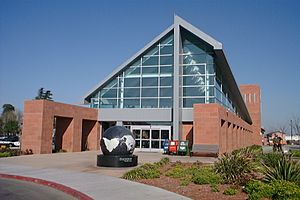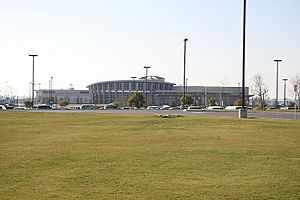Bakersfield, California facts for kids
Quick facts for kids
Bakersfield
|
|||
|---|---|---|---|
|
Top: Fox Theater, Padre Hotel; Middle: Beale Memorial Clock Tower, Bakersfield Californian Building, Kern County Museum; Bottom: aerial view of central Bakersfield
|
|||
|
|||
| Nickname(s):
"Nashville West"
|
|||
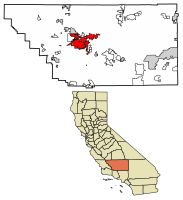
Location of Bakersfield in Kern County, California
|
|||
| Country | United States | ||
| State | California | ||
| County | Kern | ||
| Region | San Joaquin Valley | ||
| Incorporated | 1873–1876 | ||
| Re-incorporated | January 11, 1898 | ||
| Named for | Thomas Baker | ||
| Government | |||
| • Type | Council-Manager | ||
| • Body | Bakersfield City Council | ||
| Area | |||
| • City | 151.28 sq mi (391.80 km2) | ||
| • Land | 149.81 sq mi (388.01 km2) | ||
| • Water | 1.46 sq mi (3.79 km2) | ||
| Elevation | 404 ft (123 m) | ||
| Population
(2020)
|
|||
| • City | 403,455 | ||
| • Rank | 47th in the United States 9th in California |
||
| • Density | 2,666.94/sq mi (1,029.747/km2) | ||
| • Urban | 570,235 (US: 76th) | ||
| • Urban density | 4,316.0/sq mi (1,666.4/km2) | ||
| • Metro | 909,235 (US: 62nd) | ||
| Demonym(s) | Bakersfieldian, Bakersfield Californian, or Baker | ||
| Time zone | UTC−8 (Pacific) | ||
| • Summer (DST) | UTC−7 (PDT) | ||
| ZIP codes |
93220, 93301–93309, 93311–93314, 93380–93390, 93399
|
||
| Area code | 661 | ||
| FIPS code | 06-03526 | ||
| GNIS feature IDs | 1652668, 2409774 | ||
Bakersfield is a big city in Kern County, California, in the United States. It's the main city of Kern County. The city covers about 151 square miles (391 square kilometers). It is located at the southern end of the San Joaquin Valley, which is part of California's Central Valley.
In 2020, Bakersfield had a population of over 403,000 people. This makes it the 47th largest city in the United States. It is also the 9th largest city in California. The Bakersfield area, including all of Kern County, has over 909,000 people.
Bakersfield is very important for agriculture (farming) and energy production. Kern County produces more oil than any other county in California. It's also one of the top four farming counties in the United States. Many businesses in Bakersfield are related to oil, gas, mining, and food processing. The city is also famous as the birthplace of a special kind of country music called the Bakersfield sound.
Contents
History of Bakersfield
Early Days and Native Americans
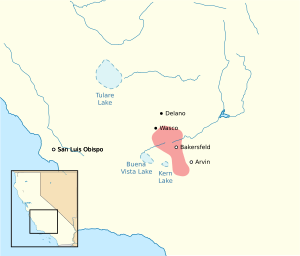
People have lived in the Bakersfield area for thousands of years. When the Spanish first arrived, the Yowlumne people lived here. They were a group of Yokuts people. Their village, Woilu, was located where Bakersfield is today.
The Yokuts people lived in lodges near the Kern River. They hunted animals like antelope, deer, and bear. They also fished and caught birds.
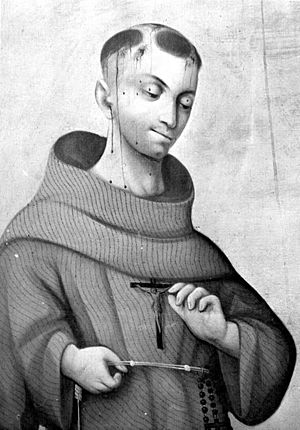
In 1776, a Spanish missionary named Francisco Garcés was the first European to visit the area. He wrote about how friendly the Yokuts people were.
For a long time, the Yokuts lived mostly by themselves. Then, after Mexico became independent, more settlers came. In 1848, gold was found in California. Many people moved to the San Joaquin Valley. In 1851, gold was found along the Kern River. Later, in 1865, oil was discovered in the valley.
The Bakersfield area used to be a marshy land with tall reeds. It was first called Kern Island by early settlers in 1860. The Kern River often flooded this area.
How Bakersfield Was Founded
In 1861, big floods washed away the first settlement. In 1863, a lawyer named Thomas Baker came to the area. He was a former colonel from Ohio. He settled by the Kern River, and his place became known as Baker's Field. It was a popular stop for travelers.
By 1870, Baker's Field had 600 people. It was becoming the most important town in Kern County. In 1873, Bakersfield officially became a city. By 1874, it became the county seat, taking over from Havilah.
However, the city had some problems, including collecting taxes. In 1876, the people voted to un-incorporate the city. This meant it was no longer an official city. For the next 22 years, a group of citizens managed the community.
By 1880, Bakersfield had 801 people. Many new residents came from states like Texas and Oklahoma. They often worked in the oil industry. The city officially became a city again on January 11, 1898.
The Railroad Arrives
In 1874, the Southern Pacific Railroad reached Kern County. But the train station was built far from Bakersfield. This was because of a disagreement over land.
Bakersfield residents wanted their own station. So, they raised money to build a second railroad. This new railroad was called the San Francisco and San Joaquin Valley Railroad. It was finished in 1898. This new railroad made Southern Pacific lower its prices.
Later, a streetcar line connected the two train stations. The new Santa Fe station was built in 1899. It was replaced in 2000 by the current Amtrak station.
The 1952 Earthquake
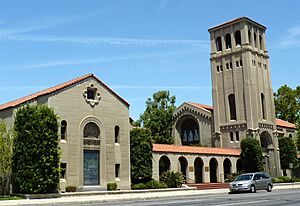
On July 21, 1952, a strong earthquake hit the area. It measured 7.5 on the moment magnitude scale. The earthquake destroyed nearby towns like Tehachapi and Arvin. It caused a lot of damage to roads and train tunnels. Bakersfield had some damage but no one died.
A week later, a big aftershock happened. It caused more damage and worried people about flooding. More aftershocks continued for a month. On August 22, another earthquake hit right under the city. Four people died, and many old buildings were badly damaged.

Growth from 1970 to 2010
Bakersfield grew a lot between 1970 and 2010. Its population increased by 400%. This made it one of California's fastest-growing cities.
Bakersfield is close to important mountain passes. This makes it a key place for transportation. In 1990, Bakersfield won the All-America City Award. This award recognizes cities that work together to solve problems.
Geography and Climate
Where is Bakersfield?
Bakersfield is located at the southern end of the San Joaquin Valley. The southern part of the Sierra Nevada mountains is just to the east. The city reaches the Sequoia National Forest. To the south are the Tehachapi Mountains. To the west is the Temblor Range, where the San Andreas Fault is found.
The city covers about 143.6 square miles (372 square kilometers). Most of this area is land. Bakersfield is about 100 miles (160 km) north of Los Angeles. It's about a 1 hour and 45 minute drive. It's also about 280 miles (450 km) southeast of Sacramento, the state capital.
Hart Memorial Park is a large park in northeast Bakersfield.
Weather in Bakersfield
Bakersfield has a hot desert climate. This means it has very hot, dry summers. Winters are mild during the day and chilly at night. The city gets very little rain, only about 6.36 inches (162 mm) per year. Most of the rain falls in winter.
Summers are extremely hot. Temperatures often reach over 90°F (32°C). There are about 36 days a year when it gets over 100°F (38°C). Sometimes, it can even reach 110°F (43°C) or more. From May to September, there is usually no rain.
Winters have mild days and cold nights. It often gets foggy in winter. This "tule fog" can be very thick and cause delays for schools. Freezing temperatures happen about 10 mornings a year. Snow is very rare in the city. The last time it snowed a lot was in 1999.
Spring and fall have pleasant temperatures. They are usually mild to warm during the day and cool at night.
Air Quality Concerns
Air quality in Bakersfield is often not very good, especially in fall and winter. This is due to wildfires and a weather pattern called an "inversion layer." An inversion layer traps pollution close to the ground. This can make the air unhealthy for days or weeks.
Pollution comes from farming, factories, trains, and cars. Oil and gas extraction also adds to air pollution. People are working to improve air quality. One idea is to bring water back to the Kern River and plant more trees.
People of Bakersfield
| Historical population | |||
|---|---|---|---|
| Census | Pop. | %± | |
| 1880 | 801 | — | |
| 1890 | 2,626 | 227.8% | |
| 1900 | 4,836 | 84.2% | |
| 1910 | 12,727 | 163.2% | |
| 1920 | 18,638 | 46.4% | |
| 1930 | 26,015 | 39.6% | |
| 1940 | 29,252 | 12.4% | |
| 1950 | 34,784 | 18.9% | |
| 1960 | 56,848 | 63.4% | |
| 1970 | 69,515 | 22.3% | |
| 1980 | 105,611 | 51.9% | |
| 1990 | 174,820 | 65.5% | |
| 2000 | 247,057 | 41.3% | |
| 2010 | 347,483 | 40.6% | |
| 2020 | 403,455 | 16.1% | |
| 2023 (est.) | 413,381 | 19.0% | |
| U.S. Decennial Census | |||
Bakersfield has grown a lot over the years. In 1880, there were only 801 people. By 2020, the population was over 403,000.
The city is very diverse. In 2020, about 53% of the people were Hispanic or Latino. This makes Bakersfield the fifth-largest city in the U.S. with a majority Hispanic population. There are also many White, African American, and Asian residents.
Most people in Bakersfield live in families. In 2010, about 47% of households had children under 18. The average household had about 3 people.
Bakersfield's Economy
Bakersfield's main industries are connected to Kern County's two biggest strengths: oil and agriculture. In 2013, Kern County produced more oil than any other county in the U.S. It is also one of the top five farming counties in the country.
Important crops grown in Kern County include grapes, citrus fruits, almonds, and carrots. Many companies involved in these industries have their main offices in Bakersfield.
The city also has a growing manufacturing and distribution sector. Many companies choose Bakersfield because land is cheaper here. It's also close to big ports in Los Angeles and Oakland. Bakersfield has policies that are friendly to businesses. For example, there are no local taxes on utilities or inventory.
Products made in Bakersfield include ice cream (it has one of the world's largest ice cream plants!), central vacuums, and racing cars.
Top Employers in Bakersfield
Here are some of the biggest employers in Bakersfield as of 2022:
- County of Kern (7,655 employees)
- Kern High School District (4,832 employees)
- Bakersfield City School District (4,041 employees)
- Dignity Health (3,432 employees)
- Bolthouse Farms (2,775 employees)
- Panama-Buena Vista Union School District (2,459 employees)
- Kern Medical Center (2,400 employees)
- Adventist Health Bakersfield (1,812 employees)
- City of Bakersfield (1,718 employees)
- Kern County Superintendent of Schools (1,665 employees)
Arts and Culture in Bakersfield
Food and Museums
Bakersfield is known for its Basque restaurants. These include famous places like Wool Growers and Noriega's.
The Kern County Museum has many items from the region's past. You can see exhibits like "Black Gold: The Oil Experience," which shows how oil is found. There's also "The Lori Brock Children's Discovery Museum," a fun, hands-on museum for kids. The museum also has a display about the "Bakersfield Sound" country music style.
The Buena Vista Museum of Natural History has a collection of old marine fossils. These fossils are from the Miocene era, which was millions of years ago.
The Bakersfield Sound
Bakersfield became famous in the late 1950s and early 1960s for the Bakersfield Sound. This was a new style of country music. It used electric guitars and was very popular. Buck Owens, Dwight Yoakam, and Merle Haggard were some of its most famous stars.
Buck Owens moved to Bakersfield in 1951. He and other musicians created this new sound. In 1996, Buck Owens opened the Buck Owens Crystal Palace. It's a music hall, restaurant, and museum in Bakersfield.
Merle Haggard was born and grew up in Oildale, near Bakersfield. His early songs often talked about his life and working-class jobs in the area.
The Bakersfield Sound has inspired many country artists. Dwight Yoakam even covered Buck Owens' song "Streets of Bakersfield," and it became a number one hit.
Music Styles
Classical Music
The Bakersfield Symphony Orchestra has been performing classical music since 1932.
Country Music
Bakersfield is known for the Bakersfield sound. This style uses electric guitars and steel guitars. It was made popular by local country singers like Buck Owens and Merle Haggard.
Doo-wop Music
Bakersfield also has a history with Doo-wop music from the 1950s and 1960s. Groups like The Paradons and The Colts were from Bakersfield.
Rock Music
The Rolling Stones mentioned Bakersfield in their 1978 song "Far Away Eyes." They used the "Bakersfield sound" style in this song.
Metal Music
In the early 1990s, the nu metal band Korn formed in Bakersfield. The band members went to different high schools in the city. Korn has sold millions of albums worldwide. On February 24, 2006, the mayor of Bakersfield declared it "Korn Day." A road near the Rabobank Arena was even named Korn Row.
Bakersfield is also home to other metal bands like Cradle of Thorns and Adema. The Deathrock group Burning Image is also from Bakersfield.
Fun Events
Bakersfield hosts many events throughout the year.
- Horse Shows: There are horse shows all year long.
- Scottish Games: Every spring, Bakersfield hosts Scottish Games and Clan Gatherings.
- Greek Festival: In late summer, St. George's Greek Orthodox Church has an annual Greek Festival.
- Lowrider National: During the summer, the Lowrider National event takes place at the Kern County Fairgrounds.
- Basque Festival: On Memorial Day weekend, there's a three-day Basque Festival with food, music, dance, and handball.
- March Meet: In March, Famoso Raceway holds a big drag racing event called the March Meet.
- Native Gathering: The CSUB Indigenous Native American Club hosts a Native Gathering twice a year.
- Kern County Fair: In September, the annual Kern County Fair shows off local farm products and animals. It also has a rodeo and concerts.
Entertainment Spots
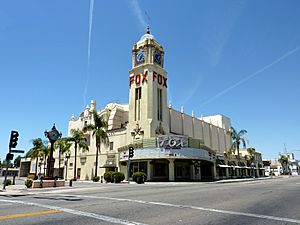
Bakersfield has several movie theaters. The historic downtown Fox Theater has been fixed up. It is now a place for concerts, musicians, and comedians. The Bakersfield Community Theatre is the oldest "live" community theater in California.
Sports in Bakersfield
Bakersfield does not have teams in the biggest professional sports leagues like the NFL or NBA. However, it is home to two minor league professional sports teams:
- Bakersfield Condors: An American Hockey League (AHL) hockey team.
- Bakersfield Train Robbers: A baseball team in the Pecos League.
The city also has two colleges with strong sports programs:
- Bakersfield College: Their teams are called the Bakersfield Renegades. They compete in 19 different sports.
- California State University, Bakersfield: Their teams are the Cal State Bakersfield Roadrunners. They compete in NCAA Division I sports.
Bakersfield is also home to famous athletes. These include baseball player Colby Lewis and NFL players Joey Porter, David Carr, and Derek Carr.
Motor Racing
Bakersfield is close to many motor racing tracks. You can find drag racing at Famoso Raceway. There's dirt track racing at Bakersfield Speedway. Road course racing happens at Buttonwillow Raceway. There's also a paved oval track at Kern County Raceway Park. Drag boat races are held at Lake Ming.
Famous race car drivers from Bakersfield include Rick Mears, who won the Indianapolis 500 four times. Kevin Harvick, a NASCAR champion, is also from Bakersfield.
Sports Venues
Bakersfield has many places for sports. The Mechanics Bank Arena (formerly the Centennial Garden) hosts concerts and sporting events. The Kern County Soccer Field has 24 soccer fields. The Bakersfield Sports Village is being built. It will have many baseball, football, and soccer fields.
Education in Bakersfield
Some of the first schools in Kern County opened in the 1860s. The Bakersfield City School District (BCSD) is the largest elementary school district in California. The first high school, Kern County Union High School, opened in 1893. It is now called Bakersfield High School.
Bakersfield College was founded in 1913. It moved to its current location in 1956. It has about 16,000 students. The Kern High School District has grown to 19 high schools and over 35,000 students. This makes it the largest high school district in California.
In 1965, California State University, Bakersfield (CSUB) was founded. It has about 10,000 students. CSUB is now a Division I athletic school.
High Schools in Bakersfield
Bakersfield is part of the Kern High School District (KHSD). This is California's largest high school district. It has 28 schools and teaches about 35,000 students. There are 17 high schools within the KHSD in Bakersfield:
- Arvin High School
- Bakersfield High School
- Centennial High School
- Del Oro High School
- East Bakersfield High School
- Foothill High School
- Frontier High School
- Golden Valley High School
- Highland High School
- Independence High School
- Liberty High School
- Mira Monte High School
- North High School
- Ridgeview High School
- Shafter High School
- South High School
- Stockdale High School
- West High School
There are also private high schools like Garces Memorial High School and Bakersfield Christian High School.
Colleges and Universities
California State University, Bakersfield
California State University, Bakersfield (CSUB) is a public university. It was founded in 1965 and opened in 1970. The campus covers 375 acres (1.5 square kilometers). CSUB offers many different bachelor's and master's degrees. Over 10,000 students attend CSUB.
Bakersfield College
Bakersfield College (BC) is a public community college. Its main campus is in northeast Bakersfield. It also has two smaller campuses. BC serves over 18,000 students each semester. It offers many Associate's degree and certificate programs.
Other Colleges
Other colleges with campuses in Bakersfield include National University and University of Phoenix.
Media in Bakersfield
Bakersfield has several media outlets. The main newspaper is The Bakersfield Californian. It started from the first paper published in the area in 1866.
The city has many television stations. These include channels for ABC, CBS, NBC, Fox, and Univision. There are also several radio stations.
Transportation in Bakersfield
Highways and Roads
Bakersfield has a large network of highways. State Route 99 goes through the city from north to south. State Route 58 is a freeway that goes east. State Route 178 is a short freeway segment. Interstate 5 goes around the city a few miles to the west.
There are plans to extend some of these freeways. The Centennial Corridor will connect SR 58 to I-5. The Westside Parkway is a newer freeway in western Bakersfield.
Bakersfield is one of the largest U.S. cities not directly connected to an Interstate highway. However, SR 99 is planned to become a "Future Interstate."
Garces Memorial Traffic Circle, also called "the Circle," is a traffic circle in Bakersfield. It was built around 1932. A large statue of Francisco Garces is in the middle of the circle.
Buses
Golden Empire Transit provides bus service within Bakersfield. Kern Transit connects Bakersfield to other towns in Kern County. You can also find intercity bus services like Greyhound and Flixbus in Bakersfield.
Trains
For freight, two major railroads, Union Pacific and BNSF, serve Bakersfield.
For passengers, Amtrak California offers the San Joaquins service. The Bakersfield Amtrak station is downtown. Bakersfield is the southern end of this train route. From here, you can take Amtrak Thruway buses to other places. A station for the California High-Speed Rail system is also planned for Bakersfield.
Airport
Meadows Field Airport is Bakersfield's airport. It was rebuilt in 2012. The airport is also home to flight training schools.
Places to Visit in Bakersfield
Here are some interesting places to see in and around Bakersfield:
- Bakersfield Sign (Central)
- Beale Memorial Clock Tower (Central)
- Buck Owens Crystal Palace (Central)
- Fox Theater (Downtown)
- Kern County Museum (Central)
- Kern Veterans Memorial (Downtown)
- Padre Hotel (Downtown)
- Mill Creek (Downtown)
- The Park at River Walk (Southwest)
Sister Cities
Bakersfield has "sister cities" around the world. These are cities that partner with Bakersfield to promote cultural ties.
- Bucheon, Gyeonggi-do, South Korea
- Wakayama, Japan (since 1961)
- Cixi, Zhejiang, China
- Santiago de Querétaro, Querétaro, Mexico
- Amritsar, Punjab, India
See also
 In Spanish: Bakersfield (California) para niños
In Spanish: Bakersfield (California) para niños


